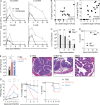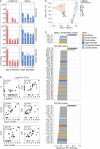Commensal microbes provide first line defense against Listeria monocytogenes infection
- PMID: 28588016
- PMCID: PMC5502438
- DOI: 10.1084/jem.20170495
Commensal microbes provide first line defense against Listeria monocytogenes infection
Abstract
Listeria monocytogenes is a foodborne pathogen that causes septicemia, meningitis and chorioamnionitis and is associated with high mortality. Immunocompetent humans and animals, however, can tolerate high doses of L. monocytogenes without developing systemic disease. The intestinal microbiota provides colonization resistance against many orally acquired pathogens, and antibiotic-mediated depletion of the microbiota reduces host resistance to infection. Here we show that a diverse microbiota markedly reduces Listeria monocytogenes colonization of the gut lumen and prevents systemic dissemination. Antibiotic administration to mice before low dose oral inoculation increases L. monocytogenes growth in the intestine. In immunodeficient or chemotherapy-treated mice, the intestinal microbiota provides nonredundant defense against lethal, disseminated infection. We have assembled a consortium of commensal bacteria belonging to the Clostridiales order, which exerts in vitro antilisterial activity and confers in vivo resistance upon transfer into germ free mice. Thus, we demonstrate a defensive role of the gut microbiota against Listeria monocytogenes infection and identify intestinal commensal species that, by enhancing resistance against this pathogen, represent potential probiotics.
© 2017 Becattini et al.
Figures







References
-
- Abt M.C., Lewis B.B., Caballero S., Xiong H., Carter R.A., Sušac B., Ling L., Leiner I., and Pamer E.G.. 2015. Innate Immune Defenses Mediated by Two ILC Subsets Are Critical for Protection against Acute Clostridium difficile Infection. Cell Host Microbe. 18:27–37. 10.1016/j.chom.2015.06.011 - DOI - PMC - PubMed
-
- Alyamkina E.A., Nikolin V.P., Popova N.A., Dolgova E.V., Proskurina A.S., Orishchenko K.E., Efremov Y.R., Chernykh E.R., Ostanin A.A., Sidorov S.V., et al. . 2010. A strategy of tumor treatment in mice with doxorubicin-cyclophosphamide combination based on dendritic cell activation by human double-stranded DNA preparation. Genet. Vaccines Ther. 8:7 10.1186/1479-0556-8-7 - DOI - PMC - PubMed
-
- Andersson A., Dai W.J., Di Santo J.P., and Brombacher F.. 1998. Early IFN-gamma production and innate immunity during Listeria monocytogenes infection in the absence of NK cells. J. Immunol. 161:5600–5606. - PubMed
MeSH terms
Substances
Grants and funding
LinkOut - more resources
Full Text Sources
Other Literature Sources
Medical
Molecular Biology Databases

